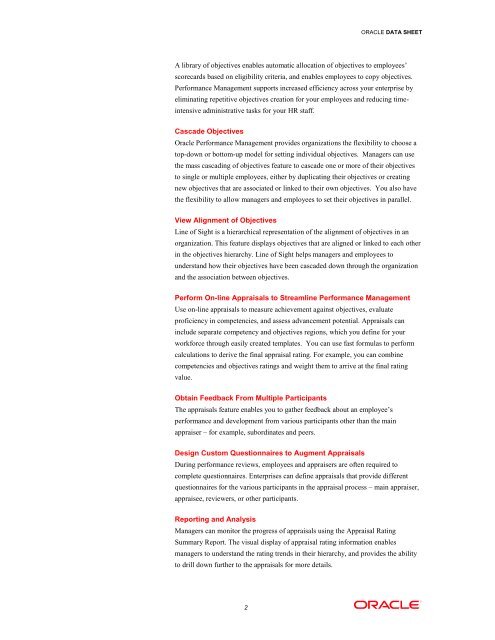Data Sheet: Performance Management - Oracle
Data Sheet: Performance Management - Oracle
Data Sheet: Performance Management - Oracle
You also want an ePaper? Increase the reach of your titles
YUMPU automatically turns print PDFs into web optimized ePapers that Google loves.
ORACLE DATA SHEET<br />
A library of objectives enables automatic allocation of objectives to employees’<br />
scorecards based on eligibility criteria, and enables employees to copy objectives.<br />
<strong>Performance</strong> <strong>Management</strong> supports increased efficiency across your enterprise by<br />
eliminating repetitive objectives creation for your employees and reducing timeintensive<br />
administrative tasks for your HR staff.<br />
Cascade Objectives<br />
<strong>Oracle</strong> <strong>Performance</strong> <strong>Management</strong> provides organizations the flexibility to choose a<br />
top-down or bottom-up model for setting individual objectives. Managers can use<br />
the mass cascading of objectives feature to cascade one or more of their objectives<br />
to single or multiple employees, either by duplicating their objectives or creating<br />
new objectives that are associated or linked to their own objectives. You also have<br />
the flexibility to allow managers and employees to set their objectives in parallel.<br />
View Alignment of Objectives<br />
Line of Sight is a hierarchical representation of the alignment of objectives in an<br />
organization. This feature displays objectives that are aligned or linked to each other<br />
in the objectives hierarchy. Line of Sight helps managers and employees to<br />
understand how their objectives have been cascaded down through the organization<br />
and the association between objectives.<br />
Perform On-line Appraisals to Streamline <strong>Performance</strong> <strong>Management</strong><br />
Use on-line appraisals to measure achievement against objectives, evaluate<br />
proficiency in competencies, and assess advancement potential. Appraisals can<br />
include separate competency and objectives regions, which you define for your<br />
workforce through easily created templates. You can use fast formulas to perform<br />
calculations to derive the final appraisal rating. For example, you can combine<br />
competencies and objectives ratings and weight them to arrive at the final rating<br />
value.<br />
Obtain Feedback From Multiple Participants<br />
The appraisals feature enables you to gather feedback about an employee’s<br />
performance and development from various participants other than the main<br />
appraiser – for example, subordinates and peers.<br />
Design Custom Questionnaires to Augment Appraisals<br />
During performance reviews, employees and appraisers are often required to<br />
complete questionnaires. Enterprises can define appraisals that provide different<br />
questionnaires for the various participants in the appraisal process – main appraiser,<br />
appraisee, reviewers, or other participants.<br />
Reporting and Analysis<br />
Managers can monitor the progress of appraisals using the Appraisal Rating<br />
Summary Report. The visual display of appraisal rating information enables<br />
managers to understand the rating trends in their hierarchy, and provides the ability<br />
to drill down further to the appraisals for more details.<br />
2

















